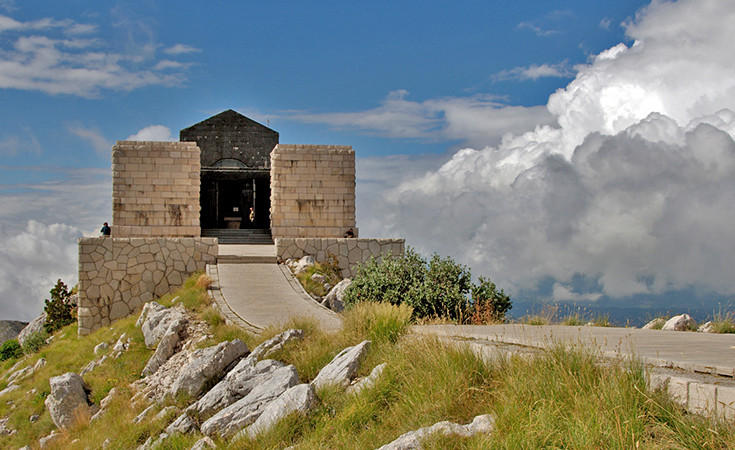
The Njegoš Mausoleum is located at the very top of the Lovćen mountain, at the Jezerski Peak some 1660 meters above sea level. The mausoleum was built to house the remains of Petar II Petrović-Njegoš. Petar II was a Montenegrin ruler, poet, Vladika and a pinacle of bravery, the man who strived to free his people from slavery, as well as to make the country prosper economically, socially, culturally and spiritually. Njegoš often spent time at the top of the Lovćen mountain, which enabled him to look at the view of the beautiful Bay of Kotor. As he was a very wise man, Njegoš’s request was that he be buried at the second-highest peak of the mountain, so that he would leave room for some future ruler of Montenegro who may be better than he was. His wish was obeyed, and the highest peak of the Lovćen mountain is still waiting for a worthy figure to occupy it.
Originally, this spot saw the construction of a chapel based on what Njegoš wanted to be buried in. However, the chapel was destroyed during World War One (precisely, in January, 1916), but was thankfully rebuilt in 1925 by the orders of King Aleksandar Karađorđević. After the end of World War Two, the newly-formed government ordered the chapel’s demolition, in order to build a mausoleum in its place.
The famous sculptor Ivan Meštrović created a sketch of the mausoleum, but it is said that he didn’t live to see the completion of his work at the mountain top. There are many different and diverging stories about how much Meštrović was paid to design the mausoleum, with many sources saying it was one of the costliest projects in the then-Yugoslavia.
The mausoleum only opened its doors in 1970 because the construction was halted for a period of time. Njegoš had originally been buried in the Cetinje Monastery, where he remained until the mausoleum was finished. There is a narrow road leading up to the mountain top, and the road to the mausoleum begins in the Njeguši village. After the road, visitors must climb the 461 steps to the mausoleum itself. The number of steps is the same as the number of verses in Njegoš’s famous work, Gorski Vijenac.
The entrance is guarded by two granite giants, two Montenegrin women, a mother and her daughter. After you pass these two monumental figures, inside the mausoleum you will be greeted by a giant sculpture of Njegoš himself, behind which there is a staircase leading down to Njegoš’s grave, a tomb made out of white marble. The ceiling of the mausoleum is covered with 20 thousand gold mosaic tiles. The mountain top will offer its visitors a spectacular view of Cetinje and the Bay of Kotor, which is exactly what Njegoš would have wanted. The mountain invokes a cocktail of feelings in the onlooker, a very hard-to-grasp blend of respect, fear, admiration, and even love.
Njegoš died very young, at only 37 years of age, but he still managed to leave behind a great cultural legacy, as well as an example of bravery and valiance to be followed by all Montenegrins. His literary opus is vast, and his Gorski Vijenac alone has been translated into more than 100 languages.
The Lovćen mountain, as well as the Njegoš Mausoleum, are part of the Lovćen National Park.
 The entrance fee for the Lovćen National Park costs €2.
The entrance fee for the Lovćen National Park costs €2.
The entrance fee for the Njegoš Mausoleum costs €5.
Children enter at a discount fee of €2.5.
Author of the text:

Marijana Niković licensed tourist guide for Montenegro.
If you are interested in guided tours in English, please contact me at:
(Viber) 00382 68 230 241
![]()